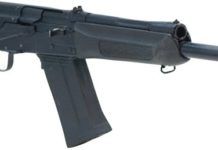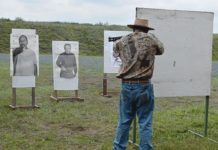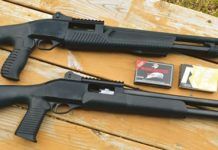Ever since the introduction of the Browning Auto-Five, autoloading shotguns have taken places of the distinction in the hunting fields across the country. The soft-shooting Remington 1100 soared to popularity in the 1960s, popularity that has since waned in favor of more versatile models. Here, we turn our critical eyes to the latest generation of the Beretta 3-inch autoloader, the Urika 2 Gold, the hypebole-laden Benelli Vinci that is new for 2009, and the re-release of the Remington CTi105-now designated the CTi105 II, also “new for 2009.” They are all $1500 or so sticker-priced autoloaders, they all claim to be technically advanced, and they are all offered solely in 3-inch models. We were extremely interested to see if the latest and greatest are what they claim to be, or not.
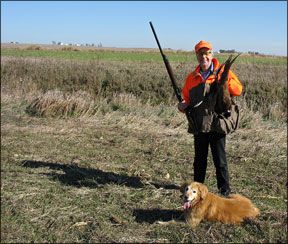
BERETTA 391 URIKA 2 GOLD NO. J39TB18
3-INCH 12 GAUGE, $1550
The Beretta Urika 2 Gold, introduced at the 2007 SHOT Show, has finally arrived. The 12 gauge with 3-inch chambers, Optima 28-inch barrel and chokes, is one of the most popular semiauto configurations offered. The Urika 2 is available with a standard walnut stock (as tested) or as the “X-tra-Grain” version (a wood stock with grain artificially burned in).
To say that we have used the Beretta 303/390/391 series extensively over the years would be an understatement. Countless models have come and gone from our working shotgun repertoire. The tested Urika 2 12/28 weighs 7.9 pounds. To compare this to identically barreled guns, an AL390 Gold Mallard weighs 8 pounds and an AL390 DU 12 gauge weighs 8.25. The steel-receiver B-80 12 gauges weigh 8.6 pounds.
Of note is the factory trigger on the Urika 2, breaking cleanly at from 4.25 to 4.6 pounds. This is one of the first semi-autos we have tested in a long while that has a good hunting trigger on it right out of the box, and we appreciate that.
Invariably, the subject of “felt recoil” comes up. Naturally, there is no clever answer beyond physics. Of the cited the 12 gauges, the softest shooter with 1200 fps 11⁄8- ounce loads remains the steel receiver Browning B-80, a gun that weighs about three quarters of a pound more. Heavier guns kick less.
Cosmetically, the Urika 2 Gold is attractive, easily the best-looking gun of the test, our team said. The oil-finished wood is well figured and darkly stained, and the fore end is evenly matched in color and tone with the buttstock. Our sole complaint is the cheesy “Optima” lettering pressed into the bottom of the forearm, an unsightly distraction. Unlike the 390s, the Urika 2 has no pistol grip cap, which is of no particular importance to us. The rest of the gun has tasteful styling accents, including the jeweled bolt and shell carrier like a Gold Mallard, to make it a gorgeous autoloading shotgun.
We wont try to call the Urika 2 revolutionary, as there is really no basis for it. This fundamental gas-operated action has always been miles ahead of the O-ring disasters that have populated semiauto shotguns for a long while. The 302/303-series action was always a good one, with the sole caveat that it was non-compensating. The more gas flow through the ports, the more bolt speed you tend to get. When some of us tried to turn 12-gauge loads into 20-gauge loads, out came the drill bits to adjust for the super-light loads. On the other end of the spectrum, a barrel change was required (to
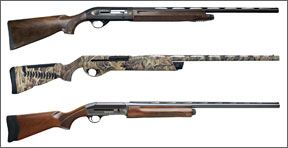
3-inch chambers) to reduce the bolt speed on the gassier 1.25- to 1.5-ounce loads or to use 3-inch shells.
Times have changed, though, and many of us cannot bear the thought of a friction ring adjustment (A-5) or tuning our gas semiautos to get the proper 6- to 8-foot hull-ejection distance. We want 12 gauges that handle 20-gauge payloads as well as what was once considered 10-gauge payloads without any adjustments. Beretta answered that with the 390, the spring attenuated secondary forearm gas vent neatly giving us 1- to 17⁄8-ounce load (and heavier) capability.
The Urika 2 fit us so well out of the box that we didnt need to think about swapping stock shims (which are included) along with a total of five Optima chokes and a plastic Beretta hard case. It was hard for us to miss with this gun. Folks tend to ask the same questions, so we will answer them as best we can. No, the Beretta Optima barrels do nothing to improve patterning or lessen felt recoil. Nor do any other factory overbored barrels, regardless of brand. The only thing can say about them is that they have screwed up the notion of choke constriction for a lot of people, as there can be no known exact constriction unless you know your individual guns bore diameter and the exit diameter of the individual conical-parallel choke tube. Then, it still does not translate to any pattern percentage. We still have to pattern, as the specific shell we use can and does change everything.
Many folks, ourselves included, wondered what was “broken” on the Beretta 390 that begged to be fixed? The answer was, and is, nothing of great importance. That said, a great deal of over-engineering went into the 391 forearm nut. A horribly complex, parts-intensive little goblin, it has more parts to it (seven) than the 303-genre gas system itself. Beretta decided that a slimmer forearm made the shotgun more appealing, and the 391 accomplished that. By now, with something approaching 1.7 million shotguns sold, it seems clear that whether rational or not, Beretta made no great mistake. It does feel livelier in the hands than a 390, and the forearm makes the gun appear more streamlined, we thought.
There have been issues with defective shell carriers in the 391, to the point where many shooters have replaced their “flat” 391 carriers with Beretta 390 “bent” shell carriers-so much so that the 390-type carriers are difficult to find. Nevertheless, the Beretta Urika 2 was the only shotgun in the test with zero malfunctions.
OUR TEAM SAID: There is no true all-round shotgun. Still, the Urika 2 comes as close to it as any shotgun currently available. Whether skeet, trap, sporting clays, dove, duck, pheasant, or turkey, this gun is more than capable of handling the task. Shim-adjustable long before it was common, Beretta continues to offer that feature while some others dont. This Beretta AL391 Urika 2 Gold is soft shooting, not fussy about what you feed it, and it comes with a trigger that is fine right out of the box. We award this Beretta an A rating, although with some caveats. We feel the 391 gas array is overly complicated, and it is painful to clean compared to its own predecessors. Nevertheless, it goes a very long time with no internal cleaning needed.
BENELLI VINCI MAX-4 CAMO
3-INCH 12-GAUGE NO. 10525, $1479
“Whats In The Box?” has been a marketing question Benelli has asked for some time now, though the over-the-top Vinci ad campaign was likely more tongue-in-cheek than serious. We can tell you now “whats in the box.”
For starters, it was a really crummy box, a clumsy polyformed plastic Professor Gadget-style gun box. The barreled action was on one side, covered with a cheap plastic flipper that was insufficient to keep it from flapping around in transit. The buttstock and the “lower” (forearm trigger group) properly remained on the other side of the flap. The owners manual was stuck into a little slit; the entire presentation was a giant advance to the rear in practical packaging. Benelli did add one touch we appreciated-a handy case with the four extra choke tubes and wrench inside. This choke-tube hard case is a nice step up from the loose clear tubes and plastic caps as supplied with the Urika II and Remington.
While on the subject of choke tubes, Benelli makes little distinction between their different types of “Crio” tubes. The Vinci uses a conventional 12-gauge bore, which is to say it is not overbored or what manufacturers try to pass off as “backbored.” The threads are roughly in the center of the choke tubes; this is what Trulock calls “Crio Plus” though it seems to Benelli, all Crio tubes are the same whether they are or not.
Because of a shipping snafu, we first had a 28-inch-barrel model when we had wanted a 26-inch version. Since we had both at one point, we tested the triggers and found them to have a reasonable trigger break right at 5 pounds. The Remington trigger was lighter and crisper, but not by a huge margin, with the Beretta having a better trigger than the Vinci as well. Nevertheless, we found the Vincis trigger better than many semi-auto shotguns, and feel that it is an acceptable hunting trigger requiring no further massaging. Beyond this, however, we decided to test the 26-inch model because it was what we wanted. We will say, though, that initial shooting of the 28-inch gun confirmed our worry that it would plow
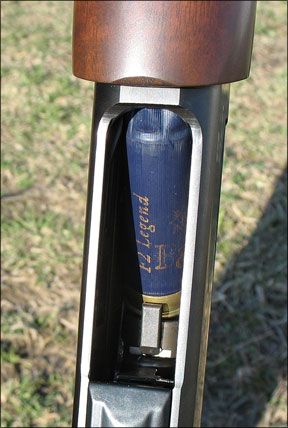
when swung. The 26-inch version was far more responsive and neutrally balanced.
Onward then. Benelli/Franchi/Stoeger (all three brands are owned by Beretta) “inertial”-branded recoil actions kick more than gas actions, we have learned. Like the Mauser Broomhandle of 1896, the bolt head is thrust back (along with the rest of the gun), where it instantly bottoms out the inertial spring against the floating bolt body. The more payload your shell has, the more quickly and harshly it bottoms that spring and punishes the shooter. When the spring is compressed, the bolt body unlocks and the “inertia spring” shoots the bolt body backward, recocking the gun and compressing the recoil spring. The recoil spring pushes the bolt back into battery, feeding a new shell as it does so. It is harsh recoil, harsher than a properly set-up A-5, our testers said.
However, since the rearward thrust upon ignition moves everything back except for the bolt body and only the inertia spring pops the bolt body backward, there can be no excessive bolt speed, as there can be with both the A-5 and gas-operated guns, which may result in receiver peening, broken links and so forth. There is less to break, and since no gas blows onto the action, there is no gas residue to clean. The Vinci gives up the 3.5-inch shell capability of the standard SBEII for better lighter-load handling capability. The basic action remains a Bruno Civolani platform from the 1960s, the primary change being the recoil spring is integral with the barreled action instead of residing inside the stock.
Stock shims were supplied, but both Vincis fit our shooters well as supplied, so we didnt mess with this adjustment. The Vinci weighed in at 7.1 pounds, a half-pound lighter than the Remington 105 CTi II or the Benelli Urika 2.
Some of the quotes promoting the Vinci beg to be answered, such as “carries like a .410, shoulders like a 20 gauge, and shoots like a 12 gauge.” No, the Vinci does not carry like a .410-it carries like any other 7-pound gun. It hardly compares in shouldering speed and responsiveness to any number of 20 gauges out there. In fact, Benellis own Ultra-Light knocks off close to a pound in 12 gauge, nearly two pounds in 20 gauge. Comments like these are more foam than beer. It does shoot like a 12 gauge, though, which is what all 12 gauges we have ever seen tend to do.
Benelli claims that the Vinci is the “fastest-shooting, softest-kicking, most reliable lightweight 12 gauge shotgun in the world.” Benelli goes on to say that “in recent lab tests, the competition had up to 72% more felt recoil than the Vinci” and finishes up by saying, “No wonder it was named for Leonardo DaVinci….”
Well, there is a lot of wonder here, to be sure. If Benelli was at all familiar with Leonardo DaVinci, they would have known that DaVinci was a vegetarian, and he used to buy caged birds only to set them free. To market a hunting shotgun based on the name of an artist repulsed by the consuming of animal meat is odd.
Of the tested shotguns, the Vinci clearly, unanimously had the most felt recoil. It was also the lightest gun tested. The idea that a lighter recoil-operated gun is going to be less comfortable to shoot than a heavier gas-operated shotgun should really be no surprise to anyone. As far as being the “fastest-shooting,” we arent sure what Benelli is trying to say there, either. Both the Winchester SX-3 and even the Browning A-5 cycle faster than the Benelli action. It isnt particularly relevant to hunting or clays sports, in our view. Weve never had the experience of waiting for a semi-auto action to close before taking a second pheasant or dove.
As for reliability, we had two malfunctions early on with the Vinci. One was the infamous “Benelli click,” where the bolt failed to go back into battery after the first shot-the next attempted shot resulting in a click, but no bang. We also had one failure to feed, where the bolt missed the next shell. We had no failures with the Beretta. To be fair, though, this was very early on in our evaluation and did not repeat. All in, after a couple of boxes of shells and a light cleaning, the Vinci was perfectly reliable with 11⁄8-ounce loads. What the Vinci is represented to actually work with is an open question. Benelli informed us directly that 11⁄8-ounce 1200 fps loads were “it” on the low end, but the Benelli USA website says the gun will function with “3 dram 1-ounce target loads.” For the 1-ounce loads, we believe that some will cycle and some wont. Finally, Benelli claims that the Vincis action is the “simplest semi-auto system ever devised.” The Vincis we tested are still not simple enough to avoid stabbing consumers in the wallet for $1479 MSRP.
With the ad-brags debunked, now we can get down to a practical assessment of the Vinci. A delayed-blowback action is going to be a harsher system than a gas system with no doubt-the gas system bleeds off some of the pressure to operate the gun. What Benelli has done here is attempted to make the entire buttstock itself a shock-isolation system, rather than the recoil pad alone. To accomplish this, a series of soft durometer rubber wedges were added to the stock. Weve seen this type of system attempted
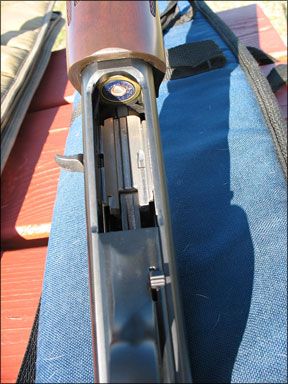
before, as in the T/C Encore “Flextech Stock with Energy Burners.” In the case of the Thompson attempt, we were able to tell no particular improvement versus a standard Encore with the same Limbsaver pad, the Limbsaver pad doing all of the recoil attenuation. With the Vinci, though, we feel that the buttstock array does provide a tangible isolation from recoil. The Vincis stock has several areas working simultaneously to isolate the shooter from the action.
We liked the Vincis recoil pad, finding it superior to the rather skimpy Beretta factory pad. The soft-rubber wedge on top of the buttstock near the recoil pad and the wedge on the bottom of the buttstock aft of the pistol grip offered the most compression. These two primary wedges, the recoil pad, and some indeterminate amount of complete buttstock flex all combined to work as an effective system. But as for the “competition had up to 72% more felt recoil” claim by Benelli, our team said the Vinci kicked the hardest of the shotguns we tested here. But it is also the lightest.
The modularity of the Vinci proved to be a mixed bag. Being able to twist on a buttstock is of no practical value to us; we dont go hunting with the idea of “some assembly required.” Twisting on buttstocks in the duckblind doesnt make a lot of sense to us. Nor does being able to switch out magazine tubes: no extra magazine tubes are supplied or required for most hunting applications. The one area we did appreciate is hitting the forearm button, twisting the forearm knob and being able to quickly remove the Vinci “lower,” which is the forearm/trigger group. This makes cleaning your trigger group a breeze, without having to use any tools or taking the time to drive out receiver pins. Also, by virtue of the Vincis delayed blow-back action, there arent any gas ports in the barrel to monitor.
The more we used the Vinci, the more we appreciated some other features. The bolt release is generous; it is hard to miss even with cold, gloved hands. Benelli also did a fine job with the loading gate: feeding shells into the magazine is effortless and natural, a huge advantage over the temperamental Remington, for example.
OUR TEAM SAID: The Benelli Vinci comes nowhere near to living up to its hyperbole. Benelli shamelessly proclaims, “The innovative ComforTech Plus System makes the Vinci the worlds lightest and softest-kicking shotgun.” It is neither, in our opinion. The Vinci is a competent shotgun, though. For a dedicated clays gun, wed skip the Vinci in favor of the Urika II or other heavier, softer-shooting gas models. Flipside: If we were going pheasant hunting or heading to the duck blind tomorrow, wed grab the Vinci.
REMINGTON 105CTi II NO. 81031
3-INCH 12 GAUGE, $1559
Time can be a very harsh judge of a newly introduced shotgun. Remingtons 105 has an “interesting” history, to put it mildly. Apparently intended to be introduced in 2005, it was delayed until 2007. In 2007, it won the “Shooting Sports Industry Academy of Excellence Shotgun of the Year Award.” Though quite a mouthful, some of these awards are beyond meaningless. So it was with the 2007 105CTi, a model that quickly gained a reputation, not at all a favorable one. Originally announced as a $1200 retail product, its price ballooned to $1500 in short order. For 2009, the revamped 105 “II” retails for $1559.
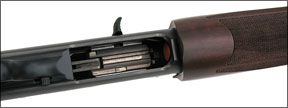
The 105 originally had a “Trinyte” metal finish. Though unchanged, it is now called “Armorlokt” by Remington. Though the original 105 bragged of “crisp 3- to 4-lb. trigger pulls” it was wishful thinking. This tested article breaks right at 4 lbs. Not what was originally claimed, but nevertheless a very good trigger, better than most factory shotgun triggers, and one thing we liked about this 105 CTi II right away. The Beretta had a slightly lighter trigger, but the Remington trigger was crisper breaking with less creep, testers said.
The 105 weighed in the area of 7.6 pounds. No, it is not the 7 pounds claimed by Remington on its website, nor is it the 7.3 lbs. now stated by Remingtons current presentation materials. But it is a well-balanced nimble-handling shotgun that is lighter than similarly configured 1100s and 11-87s. Losing about half a pound from its predecessors is an accurate claim.
The rework of the 105 II is substantial. According to Remington, we have trigger-plate changes, action-sleeve changes, action sleeve-seal changes, and bolt-head changes. On top of that, we have barrel-assembly modifications, including gas-cylinder changes, carrier, and carrier-buffer changes. Most of these parts have received nickel plating and Teflon coating. There are also improved gas seals and a length-of-pull kit, giving the shooter three -inch spacers to add.
Remington now makes clear what this gun is designed to operated with: 2-inch 3-dram 11⁄8-ounce loads on the low end and 3-inch 13⁄8-ounce loads (1450 fps) on the high end. For maximum reliability, 200 shots with the factory-applied break-in lube are suggested. But what are realistic cleaning intervals? The manual tells you to clean after every use. That means yanking the trigger group (needed to remove the breechblock), and disassembly of the complete bolt assembly. This is covered in the manual in over 70 documented steps to disassemble, clean, and reassemble the 105CTi II over five pages of text and illustrations.
We all felt that the 105 II was lighter, quicker handling and softer shooting than an 1100. We all liked the speed-loading, the speed-unloading, and the upscale trigger. Regular loading into the magazine was problematic, though, as discussed later. Though a reasonably attractive firearm, cosmetically, the number of “Rs” popped on the gun and the “105 CTi” impressed into the forearm was a bit much for us. The walnut was good quality, with distinct mineral streaks. The wood-to-metal fit was consistent, using a bit of proud wood on the buttstock to receiver area, apparently by design.
The 105CTi II is a smooth-shooting and smooth-handling 12 gauge, to be sure. We all enjoyed shooting it (at least at first), and we all liked the bottom ejection that distinguishes this gas-operated shotgun. Despite thoroughly enjoying this gun for a short while, and having no initial reliability issues with B&P F2 11⁄8-ounce loads and some turkey loads we were patterning at the time, we were quickly left with some serious questions.
Early on we saw failure-to-eject and failure-to-feed issues, and failure of the bolt to stay locked open after the final shot. Though it may sound like multiple problems, it essentially was one thing-sluggish opening bolt speed about 40% of the time with the F2 Legend shells. Later, we saw the gun perform similarly with Federal and Remington shells. These are the same type of shells Remington tells us to use for “best results” during break-in. Specifically, the company recommends its own Nitro 27 loads. A half case of 1235 fps 11⁄8-ounce loads should reasonably break-in a gas auto. In this case, it clearly didnt-the gun remained unreliable throughout our tests, even with heavier loads.
We arent really sure where this gun fits into the market. If the goal is a waterfowl gun, we dont see how the walnut/blued configuration, which we generally prefer, allows it to compete against the less costly Winchester SX3, Browning Silver, and Browning Maxus models. We dont see how this platform can easily be extended to offer 3-inch shell capability that the Browning Gold has in certain models (the Maxus does as well), the Beretta Extrema has and the Benelli Super Black Eagle has long had.
The 105s narrow range of shell function is adequate for most hunting purposes, but 1-ounce loads long handled by the Browning Gold, Beretta 390/3901/391 and a couple of others seem out of the 105s design parameters. Though lightweight compared to most 1100s, it still is substantially heavier than the Benelli Vinci, Browning Maxus, and the Benelli Ultralights. There are further design flaws, we believe. For example, if you drop a shell into the bottom of the receiver, it jams and will not enter the magazine. The magazine is offset from the bottom of the breechblock enough so interference of the hull with the top of the magazine tube is a virtual certainty.
OUR TEAM SAID: Our best guess is that for reliability, the 105 will need a thorough cleaning every 250 shots or so. Our test gun never was dependable, having a mind of its own from day to day on whether it wanted to cycle or not. With a cleaning sequence that is this lengthy, it does not compare favorably with other autoloaders. Elsewhere, Remington added the length of pull kit but not include adjustable drop or cast shims like the Beretta 391 and Benelli Vinci did. The guns $1550 retail price will make it harder to convince 3901, SX3, and Browning Silver customers to part with the 50% extra green for this model. Even Remington brand fans might have a tough time opting for this model over a $772 11-87, or an $1105 “Sporting 12” 1100 as a clays gun. We believe the Remington 105CTi II, despite its smooth, pleasant single-shot operation, is $500 too much and five years too late.
Right after our jams, we immediately contacted three principal officials at Remington, asking for an explanation of or solution to the malfunctions. We sent pictures that showed what the gun was doing. That was more than two months ago. Eventually, we received an e-mail from Remington stating, “Sorry to hear about these issues… will follow up with you ASAP on how we correct the situation.” We are still waiting for that follow-up.
























